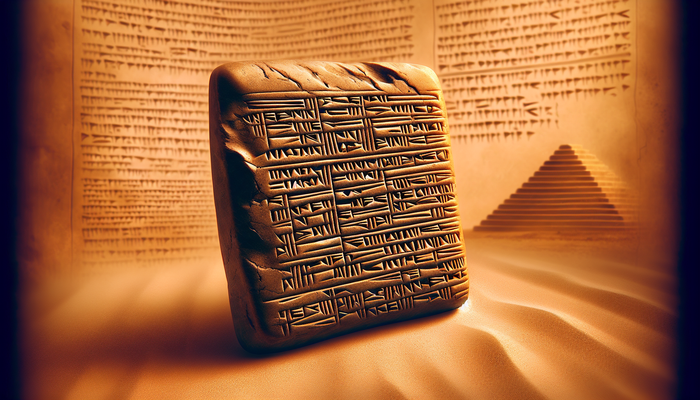Decoding Ancient Sumerian Alien Accounts

By Vanessa Torres, Ufologist
In the sun-baked lands between the Tigris and Euphrates rivers, the world's first major civilization appeared with bewildering speed. The Sumerians, who emerged around 6,000 years ago in what is now Iraq, brought with them a tsunami of innovations that form the bedrock of our modern world: writing, mathematics, astronomy, agriculture, law, and organized urban centers. These weren't small advances—they were quantum leaps in human development that appeared in a historical blink.
The mystery that has puzzled scholars for generations isn't just what the Sumerians created, but how they managed to create so much, so quickly, when the rest of humanity remained in relatively primitive states. The Sumerians themselves had a straightforward explanation for their remarkable achievements: they learned it all from the gods—beings they called the Anunnaki.
But were these really gods? Or could they have been something else entirely?
The Sumerian Miracle: Civilization's Sudden Emergence
"When we look at the ancient Sumerian civilization, we attribute them with over 100 of the firsts for a modern society," notes researcher Jason Martell. "Things like agriculture, science, medicine, mathematics, kingship, laws, courts, judges, schools... literally all of this shows up in Sumerian times 6,000 years ago, right out of the Stone Age."
The Sumerians didn't just invent writing—they pioneered an intricate system called cuneiform that allowed them to record everything from astronomical observations to receipts for grain deliveries. They didn't just count—they developed sophisticated mathematics including the sexagesimal (base 60) system we still use for measuring time. Their understanding of astronomy included detailed knowledge of planetary movements that some researchers claim exceeded what should have been possible with naked-eye observation.
Robert Mullins explains: "Ancient Sumeria in southern Mesopotamia is often cited as the most ancient civilization, even the first civilization. It goes back to approximately 3,000 to 4,000 BC. And here, we see writing in the form of cuneiform tablets on clay and on stone."
What makes this explosion of knowledge so striking is its rapidity. Unlike other early civilizations that show clear evidence of gradual development, Sumerian innovations appear in the archaeological record with limited precedent. This has led some researchers to question whether the Sumerians developed these technologies independently or received assistance from an outside source.
Who Were the Anunnaki? Gods or Cosmic Visitors?
Central to understanding claims of ancient alien contact is the identity of the Anunnaki. In conventional archaeological interpretation, the Anunnaki were simply deities in the Sumerian pantheon—powerful gods who controlled various aspects of the world and human life.
The term "Anunnaki" comes from Sumerian, traditionally translated as "princely offspring" or "offspring of Anu" (the supreme sky god). However, alternative translations have been proposed, including "those who from heaven to earth came," which forms the foundation for extraterrestrial interpretations.
William Henry describes them as "among the most mysterious and powerful beings of myth and sacred tradition. The Sumerians described them as humanoid but non-physical spirit beings who had the capability of morphing or phasing into human form. They came to Earth on a special mission to bring wisdom, and also to mine certain materials from the Earth plane itself."
The ancient texts describe these beings with attributes that some researchers find technologically suggestive:
"What we're looking at here is a Sumerian tablet that actually shows the tree of life flanked by divine beings. You can see here the Anunnaki on each side. We also see the winged disk, a symbolic reference that the Anunnaki had the power of flight. They actually had necklaces with astronomical references—a moon, a star, various symbols, which even could be symbolized as a wristwatch, technology being used 6,000 years ago."
These descriptions have led some to propose that what the Sumerians interpreted as "divine" characteristics were actually misunderstood technology—wings representing flight capabilities, radiance describing artificial lighting or energy fields, and "voices like thunder" suggesting amplified communication devices.
Zecharia Sitchin's Revolution: The Earth Chronicles
No examination of Ancient Sumerian Alien accounts would be complete without discussing Zecharia Sitchin, whose theories fundamentally reshaped modern discourse on this subject. In 1976, after studying Sumerian cuneiform tablets for 30 years, Sitchin published "The 12th Planet," the first in his series "The Earth Chronicles."
Sitchin proposed a revolutionary interpretation of Sumerian texts, suggesting that the extraterrestrial Anunnaki resided on a planet called Nibiru, which he identified as the "12th planet" in our solar system (counting the sun, moon, and Pluto). According to his translations, these beings came to Earth approximately 450,000 years ago with a specific mission: to mine gold.
Nick Redfern explains: "Zecharia Sitchin wrote a number of well-received books on the Anunnaki, which he believed were basically extraterrestrial entities from a planet called Nibiru, which he quite controversially believed actually exists in our solar system. His theory was they upgraded the human race and used them as sort of a slave species."
Sitchin's core claims included:
- The Anunnaki originated from Nibiru, a planet with a 3,600-year elliptical orbit
- They established mines on Earth to extract gold needed to repair Nibiru's deteriorating atmosphere
- When the mining work proved too difficult, they created humans through genetic engineering
- Human civilization was directly guided by these beings, explaining the Sumerians' rapid advancement
- Many biblical stories derive from actual interactions with the Anunnaki
As one source states: "The Anunnaki had damaged their atmosphere, and by using gold, they found that they could patch these atmospheric holes... The Anunnaki literally came to Earth to mine the gold and when realizing it was such a toil to do so created us as a worker race to do that for them."
Engineering Humanity: The Birth of Homo Sapiens
Perhaps the most provocative aspect of the Ancient Sumerian Alien theory concerns human creation. Sumerian texts like the Enuma Elish (a Babylonian creation epic with Sumerian origins) describe how humans were created by the gods from clay mixed with the blood of a sacrificed deity.
In conventional interpretation, these are symbolic creation myths. However, ancient astronaut theorists see a more literal explanation—a description of genetic engineering using terminology available to ancient writers.
Erik Poltorak explains, "The Anunnaki create the model man. That person gets picked up as a story in the Bible, and he's called Adam. What I find interesting is that the Bible left out some of the most important details and cut the story short. So the Sumerian tablets, the Mesopotamian tablets, have the more detailed versions."
According to this alternative interpretation, when the texts speak of "mixing clay with divine blood," they describe combining terrestrial DNA (clay) with Anunnaki DNA (blood) to create a hybrid worker species.
MJ Evans elaborates: "The Anunnaki began to figure out how they could create a docile worker. So they took genes from a female hominid, and after many, many trials, they figured out that they could blend genes together and create the perfect being. In a sense, what these tablets are really talking about is genetic engineering and the changing of the DNA within human beings."
Billy Carson provides a more detailed account: "Isis... takes an egg out of one of the existing hominids, she does something with the DNA and the genetics inside the egg... puts it in her womb... and there's a cylinder scroll with her holding up the baby saying 'my hands have made the adamu' that means first man."
This narrative suggests the initial human prototypes couldn't reproduce independently, requiring the Anunnaki to continue creating workers individually. Eventually, they succeeded in creating fertile humans who could reproduce on their own.
This interpretation attempts to explain the "missing link" in human evolution—why Homo sapiens appeared with significantly larger brains and more sophisticated capabilities than their predecessors without clear transitional fossils.
Nibiru: The Controversial 12th Planet
Central to Sitchin's interpretation is Nibiru, which he described as a large planet with a highly elliptical 3,600-year orbit that periodically enters our inner solar system. According to his theory, Nibiru is the Anunnaki homeworld and played a crucial role in our solar system's formation.
Sitchin claimed that Nibiru was involved in a catastrophic collision with a planet called Tiamat early in our solar system's history. This collision allegedly destroyed Tiamat, creating Earth and the asteroid belt. During this event, Nibiru supposedly captured Pluto as a moon and altered the orbits of other planets.
This astronomical scenario has been thoroughly rejected by the scientific community. As astronomer C. Leroy Ellenberger noted: "Sitchin states that from an equal start, the Nephilim evolved on Nibiru 45 million years ahead of comparable development on Earth with its decidedly more favorable environment. Such an outcome is unlikely, to say the least, since Nibiru would spend over 99% of its time beyond Pluto. Sitchin's explanation that heat from radioactive decay and a thick atmosphere keep Nibiru warm is absurd and does not address the problem of darkness in deep space."
The existence of Nibiru as described by Sitchin contradicts fundamental principles of orbital mechanics and planetary formation. NASA has repeatedly stated that no such planet exists in our solar system, and astronomical observations have found no evidence for a planet with the characteristics Sitchin described.
Physical Evidence: What the Artifacts Tell Us
The foundation for all theories about Ancient Sumerian Alien accounts comes from cuneiform tablets and artifacts discovered by archaeologists. Over 500,000 of these clay tablets have been found, providing a wealth of information about Sumerian culture, religion, science, and mythology.
Key texts that ancient astronaut theorists point to include:
- The Sumerian King List: This document records rulers who allegedly governed for tens of thousands of years. "One king, for example, ruled for 36,000 years," notes Robert Mullins. Some suggest these impossibly long reigns indicate the early rulers were either Anunnaki or human-Anunnaki hybrids.
- The Epic of Gilgamesh: One of humanity's oldest written stories, this epic includes accounts of gods, immortality quests, and a great flood. Some researchers point to descriptions of "The Landing Place" where gods ascended and descended amid fire and smoke—interpreted by some as spacecraft operations.
- Cylinder Seal VA 243: This ancient seal allegedly shows a complete solar system including Nibiru, though critics argue this is a misinterpretation of standard star symbols.
A particularly interesting recent discovery came in 2022 when archaeologists from the British Museum excavated the ancient site of Girsu in southern Iraq. They uncovered walls of two temples built roughly 4,500 years ago to venerate the Sumerian god Ningirsu, including the "White Thunderbird Temple." The discovery was significant because King Gudea, who ordered the temple's construction, claimed he received instructions from a "giant winged god"—which some interpret as a potential extraterrestrial encounter.
Perhaps most impressive is the Sumerians' astronomical knowledge. "A clay tablet translated in 2015 shows that ancient astronomers made extremely accurate mathematical calculations for the orbit of Jupiter a full 1,400 years before Europeans did," notes one source. This level of precision has led some researchers to question how such knowledge was obtained without advanced observational technology.
The Great Flood: Cataclysm and Cultural Reset
A recurring theme in both Sumerian texts and ancient astronaut theories is the story of a catastrophic flood that nearly wiped out humanity. According to Sumerian legend, the god Enlil, troubled by human overpopulation and noise, decided to eliminate humanity through a great flood. However, his brother Enki warned the Sumerian king Ziusudra (the equivalent of the Biblical Noah) to build a boat to survive.
This account parallels the Biblical story of Noah, suggesting a common source for both narratives. Ancient astronaut theorists propose this story is based on actual events—perhaps the Anunnaki leadership decided to leave Earth and allow a natural catastrophe to destroy their mining operations and created humans.
"Enlil gets enraged. He decides he's going to eliminate all the humans and created what we know as Noah's flood... Enki, like Prometheus in the Greeks, took the side of the humans and said no. They should be preserved," explains one source.
Some researchers even suggest that the "boat" described in these accounts might have been something more technologically advanced: "It's quite possible that the craft that he made to escape this flood was actually a spaceship and that he went into space in order to escape the flood and into orbit around our planet," suggests David Childress.
The flood theory serves several purposes in ancient astronaut narratives:
- It explains the absence of physical evidence of advanced technology
- It accounts for the end of direct Anunnaki presence on Earth
- It connects Sumerian accounts with Biblical narratives, suggesting a common factual basis
- It provides a mechanism for how knowledge of the Anunnaki became mythologized in later cultures
Archaeological evidence does confirm major flooding events in Mesopotamia around 2900 BCE. As one source notes: "Excavations of the great city of Shuruppak began in 1931. And it was from these excavations that they began putting together the story of King Ziusudra. At the city of Shuruppak, we find sediment deposits that appear to show a flood that occurred around 2900 BC."
The Black Knight Satellite: Ongoing Monitoring?
Some ancient astronaut theorists have connected Sumerian accounts of the Anunnaki with reports of a mysterious object allegedly orbiting Earth, known as the "Black Knight Satellite." This object, they suggest, could be an ancient monitoring device left by the Anunnaki to observe human development.
Billy Carson explains: "The Black Knight satellite is this object that is actually orbiting the Earth right now... NASA labeled it space junk really. So nobody wants to touch this thing; they don't want to say what it is, but it's been there for a long time."
According to this theory, the satellite was placed in polar orbit to provide comprehensive surveillance of Earth's surface. Carson continues: "A polar orbit... gives you the ability to see everything going on on the planet because as you orbit around the planet pole to pole and the planet rotates on its axis, you can take swaths of data from the planet—topographical data, resource data, human population data, everything."
Carson suggests this could explain references in Sumerian texts to Enlil's "all-seeing eye" that allowed him to monitor activities across the planet.
The Black Knight theory connects to claims that signals from this object were detected by Nikola Tesla in the late 1800s, by ham radio operators in 1953, and were mentioned in a 1960 TIME magazine article. However, mainstream science identifies the "Black Knight" as space debris or misidentified human satellites, with no evidence connecting it to ancient civilizations.
The Return: Prophecies of the Anunnaki's Reappearance
According to Sitchin's interpretation of Sumerian texts, the Anunnaki's homeworld Nibiru follows a 3,600-year orbit that periodically brings it back into our inner solar system. This has led to speculation about when the Anunnaki might return to Earth.
"Zecharia wrote in the book 'The End of Days' about some of the prophecy of the return. Next time Nibiru comes around, there should be another appearance of Anunnaki," explains one researcher. "Some of the Anunnaki may be really excited and happy to see what developed and what we have become. Some may be upset that we've gone too far."
Sitchin projected the next arrival of Nibiru around the year 2900 CE. While mainstream astronomers reject the existence of Nibiru, the concept of cyclical extraterrestrial visitation has become deeply embedded in both New Age spirituality and popular culture.
William Henry suggests: "Human reunions with the Anunnaki whenever they take place almost always result in the same thing, the stimulation of human evolution. The Anunnaki enter into human culture and consciousness bringing wisdom, knowledge, and often technology. So when we see a mass return of the Anunnaki based upon the past, we can expect that we will once again see new technology, new wisdom, and new ideas being seeded into human consciousness."
This narrative of pending return serves as both a cautionary tale and a source of hope for believers in the ancient astronaut theory—suggesting that humanity's "creators" might someday return to evaluate our progress or provide new knowledge.
Global Connections: Similar Stories Worldwide
One of the most compelling aspects of the Ancient Sumerian Alien theory is how it potentially connects similar myths from diverse cultures around the world. Many ancient civilizations share stories of "sky beings" who descended to Earth, brought knowledge, and sometimes created or modified humanity.
These parallels include:
- The Biblical Nephilim: Often interpreted as the offspring of "sons of God" and "daughters of men," some researchers connect these beings to the Anunnaki. "The Sumerian annunakai later became the biblical nephilim," claims one source.
- Native American Thunderbird legends: Various indigenous American cultures tell of powerful beings who descended from the sky. "In North America many First Nation myths begin with Thunderbirds... and the kachinas were the first Bringers of knowledge."
- Egyptian gods: Many Egyptian deities have been compared to Sumerian accounts, particularly bird-headed gods like Thoth.
- Aboriginal Star Beings: Australian Aboriginal traditions speak of creator beings who came from the stars to shape the Earth and humanity.
Giorgio Tsoukalos states: "The Sumerians are not the only culture that talks about this. Also in the Koran it says that language was given to us by Allah, or God. The Maya Popol Vuh says that language was given to us by the gods. The ancient Egyptian texts are saying the exact same thing."
This global pattern of similar narratives raises intriguing questions: Are these universal archetypes arising from common human psychological experiences? Do they reflect cultural diffusion of ideas across ancient trade networks? Or could they, as ancient astronaut theorists suggest, reflect encounters with the same extraterrestrial visitors by different human cultures?
Academic Critiques: The Scientific Perspective
Despite its popularity in alternative circles and popular media, the Ancient Sumerian Alien theory faces substantial criticism from the scientific and academic communities. These criticisms focus on several key areas:
- Translation Problems: Scholars argue that Sitchin and others have fundamentally misunderstood or mistranslated Sumerian texts. As Ronald H. Fritze notes, Sitchin's "assignment of meanings to ancient words is tendentious and frequently strained." Fritze adds, "When critics have checked Sitchin's references, they have found that he frequently quotes out of context or truncates his quotes in a way that distorts evidence."
- Astronomical Impossibilities: The planet Nibiru as described by Sitchin could not maintain a stable orbit as claimed. "Elementary perturbation theory indicates that, under the most favorable circumstances of avoiding close encounters with other planets, no body with such an eccentric orbit would keep the same period for two consecutive passages."
- Archaeological Context: Critics argue that alternative interpretations of artifacts typically ignore contextual evidence and established understanding of ancient artistic conventions.
- Evolutionary Biology: The development of Homo sapiens is explained by evolutionary processes without requiring extraterrestrial intervention.
William Irwin Thompson summarizes the criticism of Sitchin's literalism: "What Sitchin sees is what he needs for his hypothesis... If these are gods, why are they stuck with our cheap B movie technology of rockets, microphones, space-suits, and radiation therapy? If they are gods, then why can't they have some really divine technology such as intradimensional worm-hole travel, antigravity, starlight propulsion, or black hole bounce rematerializations?"
Mainstream historians and archaeologists maintain that Sumerian achievements, while remarkable, developed gradually through human innovation, cultural exchange, and adaptation to environmental challenges. They point to archaeological evidence of incremental development of technologies and the human capacity for innovation without external intervention.
Cultural Impact: Ancient Aliens in Modern Consciousness
Regardless of academic criticisms, Ancient Sumerian Alien accounts have profoundly influenced popular culture, inspiring books, movies, television shows, and video games. The concept has reached millions through media like:
- The History Channel's "Ancient Aliens" series, which has run for numerous seasons
- Films like "Stargate" (1994), which drew inspiration from Sitchin's ideas
- Video games like "The Conduit", which incorporate elements of Sumerian alien mythology
- The 2011 film "Cowboys & Aliens", which screenwriter Roberto Orci says featured villains inspired by Sitchin's conceptualization of the Anunnaki as gold-mining aliens
The widespread fascination with these theories speaks to their powerful narrative appeal. They address fundamental human questions about our origins, purpose, and place in the cosmos in ways that combine religious elements with scientific language.
In 2016, the impact of these ideas was demonstrated when Kazem Finjan, the Iraqi Minister of Transport, claimed at a press conference that "Sumerians had built and used an airport in the Dhi Qar Governorate to launch spaceships 5,000 years ago," citing Sitchin's work as evidence.
The enduring appeal of these narratives may stem from several factors:
- They provide simple explanations for complex mysteries: How did civilization develop so rapidly? Why are there gaps in the evolutionary record?
- They combine science and spirituality: In an age when traditional religion and modern science often seem at odds, ancient astronaut theories offer a narrative that incorporates elements of both.
- They speak to human insignificance and significance simultaneously: These theories suggest we are both the creation of more advanced beings (humbling) and potentially capable of similar advancement ourselves (empowering).
- They connect ancient wisdom with modern questions: By reinterpreting ancient texts through a technological lens, these theories suggest that ancient people possessed knowledge that modern science is only now rediscovering.
Between Stars and Clay: The Search Continues
The debate over Ancient Sumerian Alien accounts continues to evolve as new archaeological discoveries emerge and our understanding of ancient languages improves. While mainstream academia remains firmly opposed to extraterrestrial interpretations of Sumerian texts, the questions raised by these alternative theories continue to fascinate the public and inspire further research.
Perhaps the most valuable aspect of this ongoing discussion is how it encourages us to look at ancient texts with fresh eyes and ask fundamental questions about human origins and development. The extraordinary achievements of the Sumerians—regardless of how they came about—remind us of humanity's remarkable capacity for innovation and the enduring mystery of our earliest civilizations.
Whether the Anunnaki were mythological constructs, misinterpreted rulers, or actual extraterrestrial visitors remains unproven. But the ancient Sumerian texts themselves—tangible artifacts inscribed in clay thousands of years ago—continue to speak to us across the millennia, inviting each generation to interpret their meaning anew.
As Giorgio Tsoukalos concludes: "When we look at the story of the Anunnaki and their involvement in the Sumerian culture, we have to understand that this is potentially a legacy of information in looking at humanity's record to interpret where we really do come from."
As we continue to explore both our planet and the cosmos beyond, the quest to understand our origins and place in the universe remains as relevant today as it was when the ancient Sumerians first gazed at the stars and wondered about the beings they believed came from the heavens.
From Bigfoot to UFOs: Hangar 1 Publishing Has You Covered!
Explore Untold Stories: Venture into the world of UFOs, cryptids, Bigfoot, and beyond. Every story is a journey into the extraordinary.
Immersive Book Technology: Experience real videos, sights, and sounds within our books. Its not just reading; its an adventure.


























